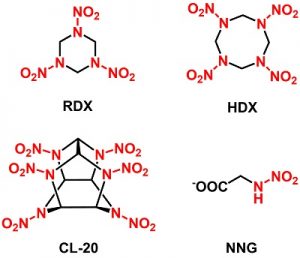The physiological functions of nitramine-containing natural products

There has been a renewed interest in discovering how bacteria install N-N bonds in natural products, but the physiological functions of these compounds are not always clear. It is often assumed that bacterial natural products are antibiotics, but sometimes these compounds are used to cooperate with other bacteria or other organisms. We work on understanding the biological purposes of bacterial natural products with nitramine (R-N(R′); R′=H or alkyl) functionalities. In man-made compounds, nitramines are critical explosophores for the compounds RDX, HMX, and CL-20. Enabling this reactivity is the propensity of this functional group to degrade to form radical species such as aminyl radicals or nitrogen dioxide (NO2). While bacterial are unlikely to use nitramine compounds as explosives, degradation of the functional group to radical species could be toxic to neighboring bacteria and therefore provide the host a competitive advantage. Alternatively, the nitramine functional group could degrade to assimilable nitrogen species, such as ammonium or nitrite, and therefore, the compound could be used exchange nitrogen with nearby bacteria. To differentiate these hypotheses, we study both the biosynthesis and biodegradation of the nitramine natural product, N-nitroglycine (NNG). This research will enable to the discovery of NPs with potential as human therapeutics, inform metal-mediated green strategies for industrial synthesis of hydrazine (N2H4) and nitramine-containing compounds, and aid in bioremediation of soil contaminants such as RDX. This work is supported by a collaboration with Dr. David Graham at Oak Ridge National Laboratory, and our NNG biodegradation work is currently funded by the Army Research Office.
Mechanisms of novel nitric oxide (NO)-dependent metalloenzymes

The reactivity of nitric oxide (NO) can all at once be beneficial and harmful to life. On one hand, it is a signaling molecule important for human physiology, an intermediate of energy-producing pathways critical for nutrient cycling, and a biosynthon of bacterial natural products; on the other hand, it can cause cell damage to an extent that is lethal. In fact, the toxicity of NO is exploited by the human immune system, which produces NO and other molecules to kill and defend against infectious microbes. The widespread functions of NO are related to the complex chemistry of NO enabled by its radical character and propensity to react with other radical species and transition metals. Many metal-containing enzymes–more simply referred to as metalloenzymes– have evolved to mediate novel chemistries using the unique reactivity of NO while others prevent the cell damage it causes. We are especially interested in studying the mechanisms of NO-dependent reactions catalyzed by metalloenzymes. Our current projects include studying the mechanism of a NO-dependent regiospecific nitration catalyzed by the cytochrome P450 homolog called TxtE. Another major project is studying the mechanism of novel NO reactivities with a hemerythrin-like protein found exclusively in pathogenic Mycobacteria, including an organism that causes tuberculosis. These projects are relevant to understanding the onset of neurodegeneration, nitrosative stress, nitrosative stress protection in infectious bacteria, installation of nitro functionalities in bacterial natural products, and engineering of nitration biocatalysts. This work is supported by collaborations with Dr. Yousong Ding (University of Florida), Dr. Victor Davidson (University of Central Florida), and Dr. Kyle Rohde (University of Central Florida).